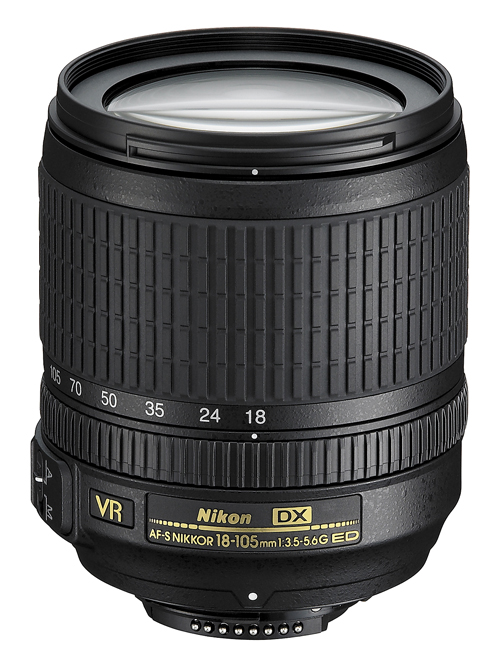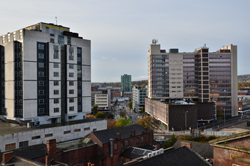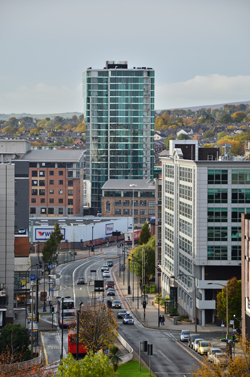Nikon AF-S DX Nikkor 18-105mm f/3.5-5.6G ED VR
 |
| Gary Wolstenholme takes a look at this popular budget standard zoom, which is currently offered as the kit lens with the Nikon D7000 camera. |
Costing only £230, this standard zoom from Nikon doesn't cost too much, but offers a useful 5.8x zoom range equivalent to 27-157.5mm on a 35mm camera. The lens also comes supplied as a kit with the Nikon D7000 and D90 cameras and is a popular lens as a result.
Alternatives within Nikon's range include their 18-200mm f/3.5-5.6 mark II, which costs around £550, but almost doubles the telephoto reach. Nikon's current lens line-up also includes their 16-85mm lens which extends the wide-angle view, at the expense of a little telephoto reach and costs around £420.
Alternatives from third party manufacturers include either of Sigma's 17-70mm lenses which offer a slightly wider angle but less telephoto and a brighter maximum aperture throughout the zoom range. The basic model costs around £250 and the model with Optical Stabilisation costs around £328. Sigma's 18-125mm with optical stabilisation may also be a suitable alternative costing around £250.
Nikon AF-S DX Nikkor 18-105mm f/3.5-5.6G ED VR: Handling and features
The design and build of this 18-105mm lens is typical of Nikon's mid range zoom lenses. The lens barrel is constructed from high quality plastics that have a textured finish to them that won't show marks or scratched too easily. The lens feels lightweight, but without feeling flimsy. The lens mount is also made of plastic, so care may need to be taken not to damage this while changing lenses. A large rubberised zoom ring fills the front half of the barrel and provides a good grip. The zoom mechanism is smooth throughout, not tightening up at any point in the zoom.
A slim focus ring is provided for manual focus adjustments, which can be applied at any time due to the inclusion of a Silent Wave Motor. Autofocus is reasonably quick in good lighting conditions, but slows noticeably when the light levels drop, especially at the longer end of the zoom. Still, for most purposes the performance in this area is more than adequate. Focus is performed internally and the 67mm filter thread does not rotate during focus of zooming, which should please users of polarsing and ND graduated filters.
Vibration reduction is included, which promises to allow sharp shots to be taken at shutter speeds three stops slower than would be possible without. At 105mm I was able to take sharp shots much of the time at 1/13sec, which is three stops below the shutter speed dictated by the usual rule of thumb to achieve a sharp shot at that focal length. With a little care I was able to stretch it to 1/6sec, getting sharp shots about half the time.
Nikon AF-S DX Nikkor 18-105mm f/3.5-5.6G ED VR: Performance
For a budget lens, Nikon's 18-105mm is a very decent performer. At 18mm the sharpness in the centre is already excellent, and the quality towards the edges is good. Stopping the lens down improves the quality towards the edges, with the best quality across the frame being achieved between f/5.6 and f/8.
Zooming to 50mm results in a slight drop off in performance, but at maximum aperture the sharpness is still very good in the centre and good towards the edges of the frame. At this focal length, peak quality across the frame is achieved at f/8, where images show very good sharpness from edge to edge.
Finally at 105mm, there is a further drop off in sharpness, but the centre resolution is still good in the centre a f/5.6 and acceptable towards the edges. At this focal length the lens needs stopping down to f/11 to achieve peak sharpness across the frame. Here the resolution is very good in the centre and good towards the edges.
Lenses with a high zoom range like this often suffer with colour fringing around high contrast edges. The 18-105mm does show some signs of chromatic aberration, but the level should be largely acceptable, unless you are producing very large prints. At their worst they just exceed pixel-width when the lens stopped down beyond f/16 at 105mm.
Falloff of illumination towards the corners is not much of an issue with this lens. At 18mm and f/3.5 the corners are only 1.85 stops darker than the image centre. Stopping down to f/5.6 results in visually uniform illumination. At 105mm vignetting is a little more noticeable at f/5.6. Here the corners are 2.47 stops darker than the image centre and the lens needs to be stopped down to f/11 for visually uniform illumination.
Barrel distortion at 18mm is quite noticeable, but not overly disturbing. Here Imatest recorded a level of 6.24% barrel distortion. At 105mm there is only 1.62% pincushion distortion present, which should only pose an issue for highly critical applications. The pattern of distortion remains constant across the frame throughout the zoom range, making it easily to correct in image editing software.
Pointing light sources in the frame may cause a little flare and certainly a loss of contrast, but even so this 18-105mm lens appears to be quite resistant to flare and ghosting. A petal shaped lens hood comes supplied, which does an excellent job of shielding the front element from unwanted light outside of the image frame.
 | DxOMark provides objective, independent, RAW-based image quality performance data for lenses and digital cameras to help you select the best equipment to meet your photographic needs. Visit the DxOMark website for tests performed on the Nikon AF-S DX Nikkor 18-105mm f/3.5-5.6G ED VR. |
Nikon AF-S DX Nikkor 18-105mm f/3.5-5.6G ED VR: Verdict
In most cases, budget zooms and kit lenses aren't all that exciting in terms of specification and performance. In this case the 18-105mm surprised me at the quality achievable, especially at 18mm and at optimum apertures throughout the range.
Those who don't need a faster maximum aperture, or larger zoom range should find this lens more than capable of delivering excellent results. For the price this lens is an excellent performer.
 |
| A great value lens capable of decent quality results. |
 Useful 'walkabout' zoom range
Useful 'walkabout' zoom range Decent optical performer
Decent optical performer Very good value
Very good value VR performs well
VR performs well Lightweight
LightweightNikon AF-S DX Nikkor 18-105mm f/3.5-5.6G ED VR: Cons
 AF noticeably slower at telephoto end of the zoom
AF noticeably slower at telephoto end of the zoom CA at 105mm and apertures below f/11
CA at 105mm and apertures below f/11| FEATURES |  |
| HANDLING |  |
| PERFORMANCE |  |
| VALUE FOR MONEY |  |
| OVERALL |  |
Nikon AF-S DX Nikkor 18-105mm f/3.5-5.6G ED VR: Lens specification
| Price | £230.00 |
| Contact | www.nikon.co.uk |
| Filter size | 67mm |
| Format | DX |
| Construction | 15 elements in 11 groups |
| Angle-of-view | 76° - 15°20’ |
| 35mm equivalent focal length (on APS-C body) | 27-157.5cm |
| Internal focusing | Yes |
| Image stabilisation | Yes |
| Minimum focus | 45cm |
| Maximum aperture | f/3.5-5.6 |
| Minimum aperture | f/22-36 |
| Weight | 420g |
| Size | 76 x 89mm |
| In the box | Lens Case CL-1018, HB-32 Lens Hood |
The Nikon AF-S DX Nikkor 18-105mm f/3.5-5.6G ED VR costs around £230 and is available from Warehouse Express here:
Nikon AF-S DX Nikkor 18-105mm f/3.5-5.6G ED VR
Nikon 18-105mm f/3.5-5.6G ED VR AF-S DX Nikkor Autofocus Lens
Vibration Reduction minimizes effects of camera shake to produce sharper images
Brand New item
67mm 3 piece Filter Kit: Ultraviolet, Florescent & Polarizer
Lens Cap Holder
More Detail : http://www.amazon.com/exec/obidos/ASIN/B007X2XBKY/tipfla-20
More Review : http://www.webcamerawebcamera.com/detail.php?id_detail=Nikon-18-105mm-f-3-5-5-6AF-S-DX-VR-ED-Nikkor-Lens-for-Nikon-Digital-SLR-Cameras-with-3-piece-67mm-Filter-Kit-%28Ultraviolet,-Florescent,-Polarizer%29-and-Lens-Cap-Holder---WHITE-BOX
Vibration Reduction minimizes effects of camera shake to produce sharper images
Brand New item
67mm 3 piece Filter Kit: Ultraviolet, Florescent & Polarizer
Lens Cap Holder
More Detail : http://www.amazon.com/exec/obidos/ASIN/B007X2XBKY/tipfla-20
More Review : http://www.webcamerawebcamera.com/detail.php?id_detail=Nikon-18-105mm-f-3-5-5-6AF-S-DX-VR-ED-Nikkor-Lens-for-Nikon-Digital-SLR-Cameras-with-3-piece-67mm-Filter-Kit-%28Ultraviolet,-Florescent,-Polarizer%29-and-Lens-Cap-Holder---WHITE-BOX
Add your message
Login required
Please login here or if you've not registered, you can register here. Registering is safe, quick and free.
Please login here or if you've not registered, you can register here. Registering is safe, quick and free.
photodo Stats
1102 lenses
428 MTF tests
74 in-depth photodo reviews
100+ users join each day
Help the lens community by reviewing or rating a lens today via our lens search
428 MTF tests
74 in-depth photodo reviews
100+ users join each day
Help the lens community by reviewing or rating a lens today via our lens search
Latest Lens Reviews
- Chinon 28mm f/2.8 Vintage Lens Review
- Canon EF 70-200mm f/4L IS II USM Lens Review
- Samyang AF 85mm f/1.4 EF Review
- Sigma 70mm f/2.8 DG Macro Art Review
- Samyang AF 24mm f/2.8 FE Review
- Meike 50mm f/1.7 Review
- Tamron 70-210mm f/4 Di VC USD Review
- Lensbaby Burnside 35mm f/2.8 Review
- Asahi Super Takumar 50mm f/1.4 Review
- Asahi Super-Multi-Coated Takumar 135mm f/3.5 Review








